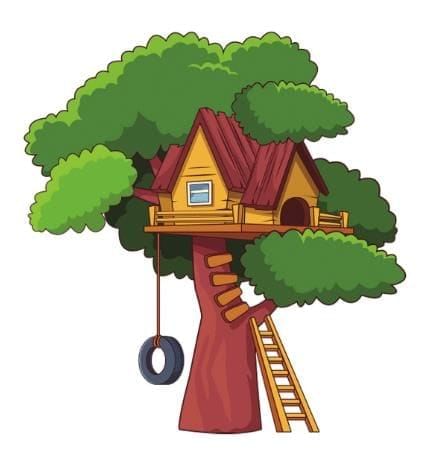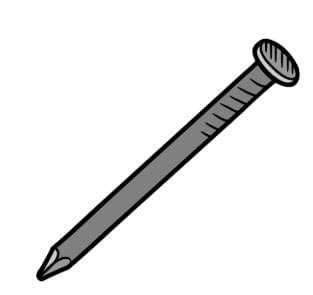Word Problem: Addition - 1 | Mathematics for Class 3 PDF Download
A. Building the Treehouse

Q1. Charlie and his dad, who is an engineer, decided to make a treehouse in their backyard. To start building, they needed more wood, so they went to gather some from the forest. They already had 15 extra planks at home. If Charlie and his dad each brought back 10 planks from the forest, how many planks do they have now in total?
 Solution:
Solution:
- Identify the numbers: 15, 10, 10
- First add 15 and 10:
15 + 10 = 25 - Then add the remaining 10:
25 + 10 = 35 - So, they have 35 planks of wood in total.
Answer: 35 planks of wood
Q2. To make the treehouse more stable, Charlie's dad decided to use rope to tie the corner posts of the treehouse to the tree. He used different lengths of rope for each post: 24 inches for the first, 20 inches for the second, 14 inches for the third, and 12 inches for the fourth post. Charlie's dad also had 15 feet of cable but didn't use it for this job. Can you figure out how many inches of rope he used in total for all four posts? Solution:
Solution:
- Write the lengths: 24, 20, 14, 12
- Add 24 and 20:
24 + 20 = 44 - Add 14:
44 + 14 = 58 - Add 12:
58 + 12 = 70 - Total rope used = 70 inches
Answer: 70 inches of rope
Q3. After finishing the treehouse, Charlie's mom treated them to some freshly baked cookies. If Charlie devoured 15 cookies, his dad enjoyed 10, and his mom had just 5. How many cookies did they eat together?
Solution:
- Numbers are 15, 10, 5
- Add 15 and 10:
15 + 10 = 25 - Add 5:
25 + 5 = 30 - Total cookies eaten = 30
Answer: 30 cookies
Q4. While building the treehouse, Charlie realized they were low on nails and decided to buy more. If they currently have 9 nails left and Charlie purchased 2 boxes of nails (one big box with 55 nails and a smaller box with 31 nails), how many nails do they have in total now?
They had 9 nails left. Charlie then bought 55 nails in a big box and 31 in a small box. Solution:
Solution:
- Nails they started with: 9
- Add 55 nails:
9 + 55 = 64 - Add 31 nails:
64 + 31 = 95 - Total nails = 95
Answer: 95 nails
Q5. Charlie and his dad are almost done with the treehouse, and now they just need to paint it. Charlie's dad figured out that they would need 20 ounces of white paint, 15 ounces of green paint, and 34 ounces of brown paint for the job. They also need to buy 6 paintbrushes. Can you calculate how many ounces of paint they should buy in total? Solution:
Solution:
- Paint amounts: 20, 15, 34
- Add white and green:
20 + 15 = 35 - Add brown:
35 + 34 = 69 - Total paint = 69 ml
Answer: 69 ml of paint
B. Annie’s Surprise Party
 Party Preparations
Party Preparations
Q1. Jessica, Annie's best friend, is organizing a surprise party for Annie's upcoming birthday. She plans to make pizza for everyone attending the party. To prepare the pizzas, Jessica bought various pieces of meat as toppings. Can you help figure out the total number of meat pieces she purchased?
Solution:
- Meat counts: 15, 10, 30
- Add pepperoni and salami:
15 + 10 = 25 - Add bacon:
25 + 30 = 55 - Total pieces of meat = 55
Answer: 55 pieces of meat
Q2. Annie's mother is also involved in the surprise party preparations. She is responsible for providing drinks for the party. To ensure there are enough drinks, Annie's mother bought 15 cans of pop and prepared several glasses of juice. The types and quantities of juice she made are as follows: 25 glasses of orange juice, 15 glasses of grape juice, and 5 glasses of apple juice. Can you calculate the total number of glasses of juice that will be available at the party?
Solution:
- Juice counts: 25, 15, 5
- Add orange and grape:
25 + 15 = 40 - Add apple:
40 + 5 = 45 - Total glasses of juice = 45
Answer: 45 glasses of juice
Q3. On the day of Annie's birthday, her friends and classmates gathered to surprise her. Among the attendees, there are 15 girl classmates, 20 boy classmates, and 3 teachers. Can you help to find out the total number of people who came to celebrate Annie's birthday?
Solution:
- Guest counts: 15, 20, 3
- Add girls and boys:
15 + 20 = 35 - Add teachers:
35 + 3 = 38 - Total guests = 38
Answer: 38 people
Q4. Annie’s friends wanted to make sure that there will be enough utensils to go around. If they already have 10 spoons and 10 forks and they bought 30 more for forks and 20 more spoons, how many utensils do they have available for the party?
Solution:
- Start with 10 spoons + 10 forks = 20 utensils
- Add new spoons:
20 + 20 = 40 - Add new forks:
40 + 30 = 70 - Total utensils = 70
Answer: 70 utensils
C. Superhero Halloween
 Halloween Treats
Halloween Treats
Q1. It’s Halloween in Chicago. Bob, Mary, John, Sue, and Sam dressed as superheroes and went out to do some trick or treating.
After passing through the houses on Main Street, the five friends counted how much candy they have. If Bob has 10 candies, Mary has 5, Sue has 20, John has 5 and Sam has 10. How many candies did they have together?
Solution:
- Candies: 10, 5, 20, 5, 10
- Add Bob and Mary:
10 + 5 = 15 - Add Sue:
15 + 20 = 35 - Add John:
35 + 5 = 40 - Add Sam:
40 + 10 = 50 - Total candies = 50
Answer: 50 candies
Q2. The friends then proceeded to the rest of the houses in their village. However, Sam had to go home earlier. She got her share of candies which are composed of 10 chewing gums, 15 chocolate bars, and 20 assorted fruit candies. How many candies did she get in total? How many candies did Sam get in total?
Solution:
- Treat counts: 10, 15, 20
- Add gums and bars:
10 + 15 = 25 - Add fruit candies:
25 + 20 = 45 - Total treats = 45
Answer: 45 candies
Q3. After Sam and Bob left, Mary, John, and Sue decided to go home as well. They counted the total amount of treats that the three of them got. They were able to sort out 60 chewing gums, 55 chocolate bars and another 40 candies of different flavors. Write an equation to find how many treats Mary, John and Sue have in total?
Solution:
- Treat counts: 60, 55, 40
- Add gums and bars:
60 + 55 = 115 - Add other candies:
115 + 40 = 155 - Total treats = 155
Answer: 155 treats
Q4. The group then went on to the houses along Broadway Street and the scary Werewolf Avenue. After the long walk, they decided to count their candy again. If Mary has 5 chewing gums and 3 chocolate bars, Sam has 10 chewing gums and Sue has 15 chewing gums, how many chewing gums did the three have in all?
Solution:
- Gums: 5, 10, 15
- Add Mary and Sam:
5 + 10 = 15 - Add Sue:
15 + 15 = 30 - Total chewing gums = 30
Answer: 30 chewing gums
Q5. Bob who is Sam’s next-door neighbor decided that he will accompany Sam home. He also took his share which consists of 15 chewing gums, 20 chocolate bars and 15 assorted candies. How many candies did he get?
Solution:
- Candies: 15, 20, 15
- Add gums and bars:
15 + 20 = 35 - Add assorted candies:
35 + 15 = 50 - Total candies = 50
Answer: 50 candies
|
18 videos|120 docs|25 tests
|
FAQs on Word Problem: Addition - 1 - Mathematics for Class 3
| 1. How can I solve addition problems? |  |
| 2. Can addition be done in any order? |  |
| 3. What is the identity property of addition? |  |
| 4. Is there a limit to the numbers that can be added? |  |
| 5. Are there any shortcuts or strategies for adding numbers mentally? |  |






















